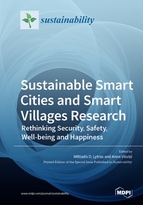Sustainable Smart Cities and Smart Villages Research: Rethinking Security, Safety, Well-being and Happiness
A special issue of Sustainability (ISSN 2071-1050). This special issue belongs to the section "Sustainable Urban and Rural Development".
Deadline for manuscript submissions: closed (30 November 2018) | Viewed by 95342
Special Issue Editors
2. Effat College of Business, Effat University, Jeddah 21551, Saudi Arabia
Interests: smart cities; smart villages; international political economy (IPE); information and communication technology (ICT)
Special Issues, Collections and Topics in MDPI journals
Interests: cognitive computing; artificial intelligence; data science; bioinformatics; innovation; big data research; data mining; emerging technologies; information systems; technology driven innovation; knowledge management; semantic web
Special Issues, Collections and Topics in MDPI journals
Special Issue Information
Dear Colleagues,
It was a pleasure to have delivered a special issue on smart cities and smart villages research this Spring 2018 https://0-www-mdpi-com.brum.beds.ac.uk/journal/sustainability/special_issues/Smart_Cities. Building on our earlier work, drawing from our field research, and driven by a genuine concern about the process and the implications of the rapid depopulation of rural areas, in Summer 2017 we introduced the concept of smart village in the academic debate. At the time of the launch of this Special Issue, we were convinced that through the adoption of comprehensive integrative strategies geared toward socio-economic development and employing recent advances in information and communication technology, ways of navigating the challenge of rapid depopulation of urban areas will be identified. Indeed, papers included in this Special Issue not only contributed to the opening of new avenues of research but also triggered a lively debate on diverse aspects of well-being in urban and rural areas as they evolve. The excellent contributions from all over the world included in that Special Issue allowed us to disseminate the latest high quality, interdisciplinary research in the domains of urban computing, smart cities, and – most importantly – smart villages. Thanks to the Special Issue, the concept of smart villages has been firmly established in the academic and practitioners’ debate. As significant streamlining of research focus and delineation of the subject matter took place as well, a major break-through was attained in the nascent field of smart villages research. To capitalize on that work, today, the imperative is to move to the next stage of the debate.
To this end, the Guest Editors of this Special Issue seek papers that address, but are not limited to, the following issues and aspects related to the diverse aspects of socio-economic processes as they unfold in rural and urban areas and have a bearing on individuals’ security, safety, well-being, and happiness:
- policy-design and policymaking for sustainable development in urban and rural areas
- public-private partnerships and the development of strategies for sustainable rural and urban development
- the role of multilateral forums, international organizations, and other in streamlining the debate
- the role of the European Union (EU) in the debate on smart villages
- comparative aspects of smart village and smart city research
- comparative approaches
- regional strategies
- smart city technologies
- smart village technologies
- smart services’ provision in rural and urban areas
- revitalization of rural areas through digital and social innovation
- case-studies
- conceptual approaches
- micro-, mezzo-, and macro-strategies, incl. applications, tools, and systems
- innovation networks in the context of smart village research
- clusters in the context of smart village research
- smart specialization in the context of smart village research
Prof. Dr. Anna Visvizi
Prof. Dr. Miltiadis D. Lytras
Guest Editors
Manuscript Submission Information
Manuscripts should be submitted online at www.mdpi.com by registering and logging in to this website. Once you are registered, click here to go to the submission form. Manuscripts can be submitted until the deadline. All submissions that pass pre-check are peer-reviewed. Accepted papers will be published continuously in the journal (as soon as accepted) and will be listed together on the special issue website. Research articles, review articles as well as short communications are invited. For planned papers, a title and short abstract (about 100 words) can be sent to the Editorial Office for announcement on this website.
Submitted manuscripts should not have been published previously, nor be under consideration for publication elsewhere (except conference proceedings papers). All manuscripts are thoroughly refereed through a single-blind peer-review process. A guide for authors and other relevant information for submission of manuscripts is available on the Instructions for Authors page. Sustainability is an international peer-reviewed open access semimonthly journal published by MDPI.
Please visit the Instructions for Authors page before submitting a manuscript. The Article Processing Charge (APC) for publication in this open access journal is 2400 CHF (Swiss Francs). Submitted papers should be well formatted and use good English. Authors may use MDPI's English editing service prior to publication or during author revisions.
Keywords
- Smart Cities
- Smart Villages
- Smart urban applications
- Data Mining
- Analytics
- Cloud computing and open source technologies
- Sustainability
- Entrepreneurship
- Economic Growth
- International migration
- Forced migration
- Smart Technologies
- ICTs
- Open Democracy
- Open Government
- Smart Education
- Smart Innovation







